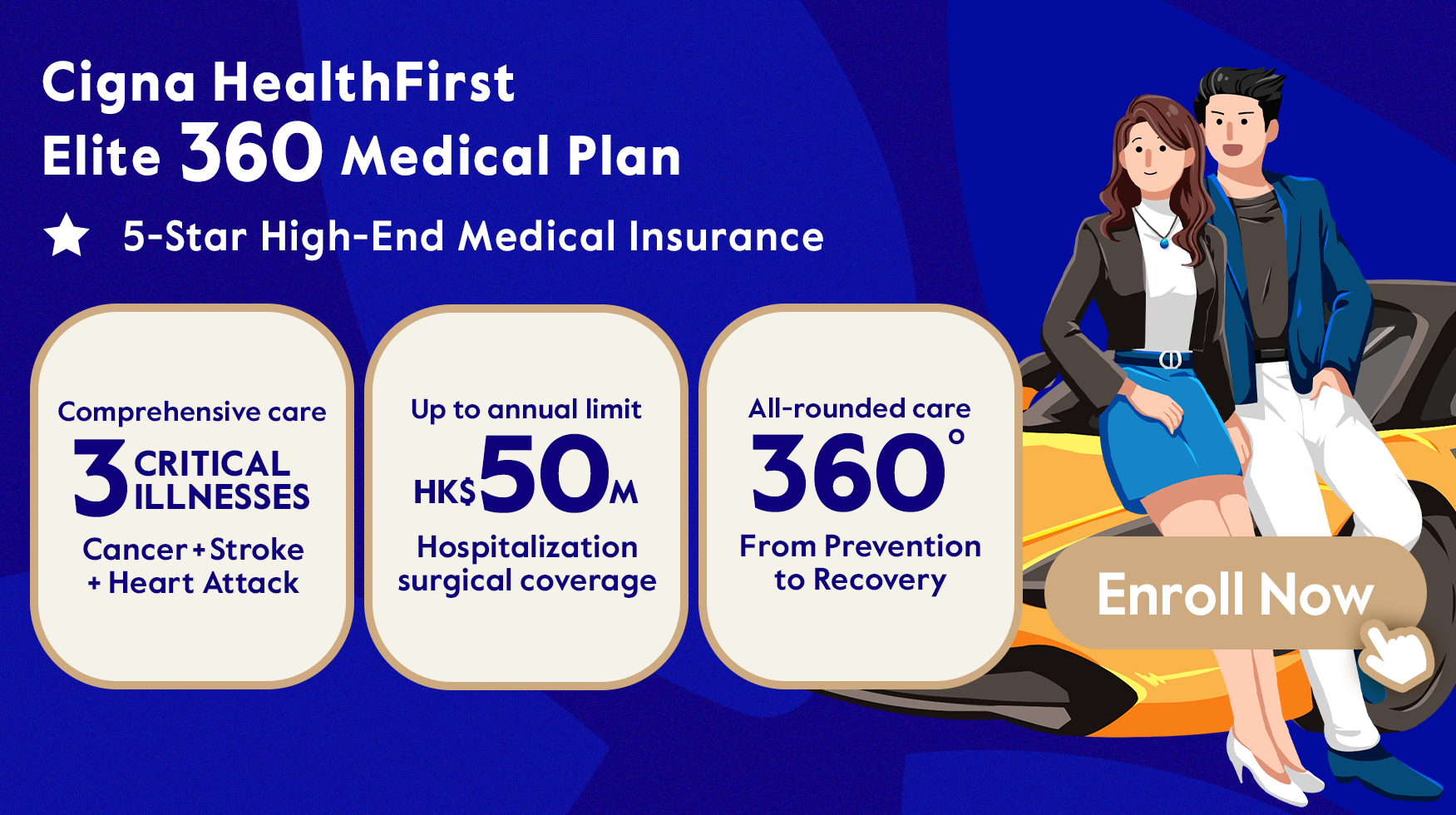Lymphoma is one of the top ten most common cancer in Hong Kong. According to the Hong Kong Cancer Registry statistics, it ranks eighth in 2018, with around 100 new cases found each year. Most people may know what lymph is or have heard of this word, but do you understand its operation and function? In this article, Cigna Smart Health is going to introduce the lymphatic system and then explain the causes, symptoms and treatments of lymphoma.
Understand the Lymphatic System
Body fluids account for 70% of the body weight, including plasma, tissue fluid, cerebrospinal fluid, cell fluid, lymph, etc. Lymph is a transparent fluid containing lymphocytes.
Lymph fluid, lymph vessels and lymph nodes comprise the lymphatic system that covers the entire body, allowing lymphocytes (lymphatic cells) to circulate throughout every organs and tissue. A lymphocyte is a type of white blood cell in the immune system which helps the body fight off diseases and eliminates abnormal cells. Therefore, the lymphatic system is critical to immunity.
What is Lymphoma?
Since lymphocytes flow throughout the body, lymphoma may start anywhere in your body. When lymphocytes grow out of control and accumulate in the lymph nodes, malignant tumours form and spread to the bone marrow, liver and other vital organs. This kind of cancer that originates in the lymphatic system is called lymphoma.
As Dr. LIANG Hin Suen, Director of Haematology and Cellular Therapy Centre, Hong Kong Sanatorium & Hospital, half of the lymphoma cases begin in lymph nodes and the other cases start in any other organs, such as the stomach, nasal cavity, thyroid or breast.
Types of Lymphoma
Lymphoma can be categorised as Hodgkin’s lymphoma and Non-Hodgkin’s lymphoma.
In Hong Kong, there are more Non-Hodgkin’s Lymphoma patients than the former one. Non-Hodgkin’s lymphoma can be further divided into indolent (low malignancy) and aggressive (medium / high malignancy) lymphomas with a ratio of 1:1.
|
Hodgkin's Lymphoma |
Non-Hodgkin's Lymphoma |
||
|
Indolent Lymphomas |
Aggressive Lymphomas |
||
|
Age of Onset |
15 to 30 years old or the elderly |
Irregular |
|
|
Major Sites of Lesion |
Lymph glands in the neck |
It may start from the tissues apart from the lymphatic system irregularly. |
|
|
Conditions |
Spread from the site to the areas nearby, underarms, thoracic cavity, abdominal cavity or distant lymph glands. Eventually spread to bone marrow and other organs. |
Grow and spread slowly; some indolent lymphomas might not need to be treated right away but can be watched closely instead. |
Grow and spread quickly; usually need to be treated right away. Patients may pass away in just a few months. |
|
Five-Year Survival Rate |
90% |
70% |
70%30%-50% |
Sources: Survival Rate of Lymphoma Can Be As High As 90%! Common Symptoms and Treatments
Stages of Lymphoma
Lymphoma’s division of stages is different from other cancers. It depends on the ‘location’ of the tumour(s) rather than the size.
- Stage I Lymphoma: Cancer is found in one lymphatic area.
- Stage II Lymphoma: Cancer is found in two or more lymph node groups either above or below the diaphragm.
- Stage III Lymphoma: Cancer is more disseminated and found in one or more lymph node groups above and below the diaphragm.
- Stage IV Lymphoma: Cancer is found throughout one or more organs that are not part of a lymphatic area, such as the liver, central nervous system and bone marrow).
Symptoms of Lymphoma
The symptoms of lymphoma are hardly noticeable and similar to those of some viral diseases, such as the common cold. However, they typically continue for a more extended period.
Six common symptoms of lymphoma include:
- Painless swelling of lymph nodes in your neck, armpits or groin
- Ongoing fever without infection
- Cough and shortness of breath
- Unexplained weight loss
- Night sweats
- Unusual itching and skin patches
Causes of Lymphoma
Doctors are not sure what causes lymphoma, but some cases may be related to genetic mutations, viral infection, radiation, chemicals and impaired immune system.
Some cases of gastric MALT lymphoma, a type of Non-Hodgkin'slLymphoma, are infected with a virus called Helicobacter Pylori, which can be deterred and cured by specific antibiotics.
How Is Lymphoma Diagnosed?
Although swelling of lymph nodes is a symptom of lymphoma, it may be caused by different illnesses or conditions, such as tonsillitis. You should see your doctor for a detailed consultation and medical diagnosis to determine if you have lymphoma.
Lymphoma can be diagnosed with the following methods:
|
Tests for Lymphoma |
Items |
Reference Fees for Diagnosing Lymphoma (HKD)* |
|
Biopsy |
Take a sample of lymph tissue from the swelling area |
|
|
Complete Blood Count (CBC) |
The test counts the number of blood cells to diagnose lymphoma. If you have a low white blood cell count, you may have a chance of lymphoma. |
|
|
CT scan, MRI scan and PET scan are used to show the condition of different organs If there is a lymphatic cancer cell invasion, you may need a spinal tap or biopsy. |
|
|
|
Bone Marrow Aspiration |
Your doctor uses a needle to remove fluid or tissue from your bone marrow -- the spongy part inside the one where blood cells are made - to look for lymphoma cells. Pain is incurred during sample collection, which requires a few days to recover. |
|
|
Lumbar Puncture (Spinal Tap) |
In this procedure, your surgeon uses a long, thin needle to remove and test spinal fluid under local anesthetic. Pain is incurred during sample collection, which requires a few days to recover. |
*With reference to the charges of local private hospitals and the Hospital Authority; prices as of 10 Apr 2021.
Treatments of Lymphoma
Treating lymphoma successfully is said to be one of the critical milestones in medical development in recent years. The innovative and effective lymphoma treatments help many patients relieve various symptoms and even recover from the deadly disease.
Your doctors may prescribe different dosages and cycles treatments per your conditions, so the fees vary among patients. The following prices are for your reference only.
|
Treatments of Lymphoma |
Items |
Reference Fees for Treating Lymphoma (HKD)* |
|
Chemotherapy |
Chemotherapy drugs can be taken orally or injected into a vein to enter the bloodstream and travel throughout the body to destroy cancer cells. |
Application and preparation costs: $2,400 per day; chemotherapy drugs are charged separately at cost. |
|
Radiation Therapy |
Use high-energy radiation emitted by a treatment machine to kill malignant tumours at specfic locations. |
|
|
Target and destroy specific cancer cells with more minor damage posed on the normal cells nearby. Targeted therapy drugs for lymphoma: Bortezomib, brentuximab vedotin, ibritumomab tiuxetan, rituximab, temsirolimus |
Average monthly targeted drug cost: $16,000 - $170,000 |
|
|
Radioimmunotherapy |
Radioimmunotherapy (RIT) is a combination of radiation therapy and immunotherapy used to treat non-Hodgkin lymphoma and other cancer types. It uses an antibody labelled with a radionuclide to deliver cytotoxic radiation to a target cell. |
Target localization - 3D conformal contouring (per session): $18,500 - $36,050 |
|
Self (Autologous) / Donor (Allogeneic) Stem cell transplants |
Extract blood stem cells from the human body, use large doses of chemotherapeutics to destroy cancer cells, and inject blood stem cells into the patient |
*With reference to the charges of local private hospitals and the Hospital Authority; prices as of 10 Apr 2021.
Diet for Lymphoma Patients
As suggested by nutritionists, lymphoma patients should have a higher intake of alkaline foods and antioxidant fruits, namely leaf vegetables, mushrooms, gourds and beans.
Some leaf vegetables, such as spinach, broccoli and carrots, are good examples of alkaline food. You could also include tofu, kelp, sea vegetables, kiwi, plum etc. in your alkaline diet.
Furthermore, lymphoma patients are advised to follow the six dietary principles below:
- Antioxidant foods
- Alkaline diet
- Avoid raw food
- Smaller-sized but more frequent meals
- Avoid irritating food
- Less meat
Lymphoma has a high recovery rate and can be completely cured. Even though you have lymphoma, you could reclaim your health with timely and accurate treatments.
Cigna HealthFirst Elite 360 Medical Plan offers comprehensive and personalized medical coverage across the stage prevention, diagnosis, treatment and recovery, with a range of hospital and surgical benefits, optional insurance benefits with an annual limit of up to HK$50 million, personalized health assessment, three critical illnesses(cancer, stroke and heart attack) all-rounded care and international medical concierge service. A 360-degree total health protection that spans across all the key stages of your health journey. Learn more here.
Sources:


